Riley Bailey, Christina Harward, Kateryna Stepanenko, Karolina Hird, and Frederick W. Kagan
Russian forces conducted a notably larger series of drone strikes throughout Ukraine on November 3. The Ukrainian Air Force reported that Russian forces launched four dozen Shahed-131/-136 drones from Kursk Oblast and Primorsko-Akhtarsk, Krasnodar Krai, and a Kh-59 cruise missile from occupied Kherson Oblast at targets in Ukraine.[1] The Ukrainian Air Force reported that Ukrainian air defenses shot down the Kh-59 cruise missile and 24 of the Shahed drones.[2] Ukrainian President Volodymyr Zelensky stated that Ukrainian forces intercepted over half of the roughly 40 drones that Russian forces launched at Ukraine.[3] Ukrainian officials reported that Russian forces struck targets in Kharkiv, Lviv, Ivano-Frankivsk, and Odesa oblasts, and Zelensky stated that Ukrainian air defenses activated in Kharkiv, Zaporizhia, Kherson, Mykolaiv, Odesa, Kyiv, Kirovohrad, Vinnytsia, Khmelnytskyi, and Lviv oblasts.[4] Ukrainian officials reported that Russian forces primarily struck civil infrastructure, and Ivano-Frankivsk Oblast Military Administration Head Svitlana Onyshchuk stated that Russian forces struck an unspecified military facility in Ivano-Frankivsk Oblast.[5] Ukrainian officials reported that Russian forces launched small groups of Shaheds to identify the locations of Ukrainian air defenses and then launched several waves of drones to complicate the Ukrainian response.[6] Ukrainian officials, including Zelensky, stated that Russian forces plan to launch more damaging strikes throughout Ukraine as winter approaches.[7]
The US Department of Defense (DoD) announced new military aid packages to Ukraine on November 3, primarily aimed at strengthening Ukraine’s air defenses. The US DoD announced an aid package of military materiel support for Ukraine valued at $125 million, including munitions for National Advanced Surface-to-Air Missile Systems (NASAMS) and HIMARS; 155mm and 105mm artillery rounds; Tube-Launched, Optically-Tracked, Wire-Guided (TOW) anti-tank missiles; Javelin and AT-4 anti-armor systems; and over three million rounds of small arms ammunition and grenades.[8] The US DoD will also allocate $300 million to the Ukraine Security Assistance Initiative (USAI) to strengthen Ukraine’s air defenses over the long term. The US DoD will provide Ukraine laser-guided munitions to counter UAVs under USAI.
Ukrainian forces continued offensive operations near Bakhmut and in western Zaporizhia Oblast on November 3. The Ukrainian General Staff reported that Ukrainian forces continued offensive operations in the Bakhmut and Melitopol (western Zaporizhia Oblast) directions.[9] The Russian Ministry of Defense (MoD) claimed that Russian forces repelled eight Ukrainian assaults in western Zaporizhia Oblast and several Ukrainian attacks near Bakhmut from October 28 to November 3.[10]
Russian milbloggers continued to criticize the Russian military command for failing to establish long-term training capabilities because it is keeping skilled commanders and soldiers at the front and leaving inexperienced careerists to train new recruits and officers. One Russian milblogger claimed that Russia continues to only learn from its mistakes at the cost of significant losses and that the Russian military command fails to teach effective tactics employed by competent commanders and servicemen to new personnel.[11] The milblogger claimed that the Russian military command commits the most capable commanders and servicemen to the most dangerous frontlines in Ukraine instead of using them to train the incoming class of Russian soldiers. The milblogger added that Russia needs to resolve this problem on a systemic level, otherwise newly formed units will repeat prior Russian mistakes on the frontline. Another Russian milblogger responded to the milblogger’s critiques, noting that Russia needs to have experienced servicemen teach graduating classes at Russian military schools since graduates only study theory and do not receive any practice in modern warfare.[12] The milblogger implied that there are problems with Russian military theory and a lack of proper officer training because generals and officers who receive teaching positions do not have combat experience and only care about their own career growth. The milblogger concluded that the poor command of Russian operations in the Avdiivka direction and near Klishchiivka (7km southwest of Bakhmut) indicates that Russian generals do not think about the wellbeing of the Russian Armed Forces in the long-term.
Alleged long-time allies of Russian President Vladimir Putin are reportedly financing two Russian Ministry of Defense–subordinated private military companies that have subsumed former Wagner Group operations in Africa. The Wall Street Journal (WSJ) reported on November 3 that the Russian Ministry of Defense (MoD), including Russian Deputy Defense Minister Yunus-Bek Yevkurov and members of the Main Directorate of the General Staff of the Russian Armed Forces (GRU), is continuing efforts to subsume Wagner Group activities in Africa under the MoD-subordinated Redut and Convoy private military companies (PMCs).[13] WSJ reported that Arkady Rotenberg and Gennady Timchenko, two Russian billionaires who have known Putin for decades and are in Putin’s inner circle, are financing Convoy and Redut, respectively. This decision is likely an attempt to prevent a single PMC and single financier from again gaining the power and influence to potentially threaten Putin and the Russian central leadership. ISW has previously assessed that Putin routinely appoints people to positions such that no one figure amasses too much political influence.[14] WSJ also reported that Konstantin Pikalov leads Convoy PMC and that Konstantin Mirzayants leads Redut PMC. Russian State Duma Defense Committee Chairman Andrei Kartopolov stated on November 3 that Wagner has “completely disbanded” and that some Wagner fighters continue to operate in Africa but under a “different brand” under the Russian MoD.[15]
Wagner elements in Syria will reportedly transfer Russian Pantsir-S1 air defense systems that Syrian President Bashar al-Assad has agreed to provide to Iranian-backed Lebanese Hezbollah. (NOTE: This text also appeared in the Critical Threats Project’s (CTP) November 3 Iran Update) CNN reported on November 3 that two people familiar with US intelligence stated that Assad agreed to provide the Russian air defense systems to Hezbollah and tasked Wagner with their delivery during joint conversations between the three actors.[16] WSJ reported on November 2 that US intelligence indicated that Wagner itself would give the Russian air defense systems to Hezbollah.[17] Israel frequently conducts airstrikes on Iranian weapons shipments into and through Syria, and Assad may have asked Wagner to deliver the air defense systems to Hezbollah to act as a deterrent to potential Israeli interdiction efforts.[18] CTP-ISW has previously assessed that Russia may be able to facilitate weapons shipments in Syria without risking Israeli airstrikes, and the Kremlin may believe that this Israeli reluctance will extend to Wagner.[19] Russia and Israel have a complex relationship in Syria, as Israel has historically relied on Russia to curb Iranian activities in Syria.[20]
Dagestani officials claimed they would punish those who participate in and organize alleged future demonstrations, in contrast to calls for leniency for those participating in the October 29 antisemitic riots. The office of the Mayor of Makhachkala called on local residents to refrain from participating in unauthorized rallies, including one allegedly planned for November 5, and preemptively threatened that participants and "those who provoke the population” will face “serious consequences.”[21] Russian milbloggers similarly claimed that Telegram channels continue to call on Dagestani residents to attend a November 5 demonstration to demand the release of those detained for the October 29 antisemitic riots.[22] A Russian milblogger continued to criticize the weak official response to the recent riots, stating that “to have mercy means to show weakness.”[23]
Chechen Republic Head Ramzan Kadyrov’s continued appeals to Chechen nationalists likely aim to solidify domestic support without disrupting his appearance as a steadfast supporter of Russian President Vladimir Putin. Kadyrov announced on November 3 that Russian Prime Minister Mikhail Mishustin signed a decree assigning original Chechen names to eight Chechen villages that suffered from Stalin-era deportations and that Soviet authorities disbanded.[24] Russian officials have increasingly suppressed acknowledgements of Stalinist deportations, yet the Kremlin’s support for reversing Stalin’s 1944 order disbanding these Chechen villages suggests that Kadyrov is coordinating his rhetorical appeals with the Kremlin.[25] This likely rhetorical overture follows similar allusions to Chechen national history from Kadyrov, who recently named two new Chechen volunteer battalions after 18th and 19th Century Chechen fighters who resisted Russian imperial rule.[26] These allusions to Chechen national history are a low stakes approach to currying favor with Chechen nationalists who may have negative attitudes towards the Kremlin and Kadyrov’s avowed support of Putin. Kadyrov’s rhetorical support for historical Chechen nationalism diverts conversations away from his current support of the increasingly ultranationalist Kremlin, while only drawing temporary ire from select Russian ultranationalists.[27]
Key Takeaways:
- Russian forces conducted a notably larger series of drone strikes throughout Ukraine on November 3.
- The US Department of Defense (DoD) announced new military aid packages to Ukraine on November 3, primarily aimed at strengthening Ukraine’s air defenses.
- Russian milbloggers continued to criticize the Russian military command for failing to establish long-term training capabilities because it is keeping skilled commanders and soldiers at the front and leaving inexperienced careerists to train new recruits and officers.
- Alleged long-time allies of Russian President Vladimir Putin are reportedly financing two Russian Ministry of Defense–subordinated private military companies that have subsumed former Wagner Group operations in Africa.
- Wagner elements in Syria will reportedly transfer Russian Pantsir-S1 air defense systems that Syrian President Bashar al-Assad has agreed to provide to Iranian-backed Lebanese Hezbollah.
- Dagestani officials claimed they would punish those who participate in and organize alleged future demonstrations, in contrast to calls for leniency for those participating in the October 29 antisemitic riots.
- Chechen Republic Head Ramzan Kadyrov’s continued appeals to Chechen nationalists likely aim to solidify domestic support without disrupting his appearance as a steadfast supporter of Russian President Vladimir Putin.
- Russian forces conducted offensive operations along the Kupyansk-Svatove-Kreminna line, near Bakhmut, near Avdiivka, west and southwest of Donetsk City, near Vuhledar, in the Donetsk-Zaporizhia Oblast border area, and in western Zaporizhia Oblast and advanced in some areas.
- Kremlin-affiliated milbloggers began advertising recruitment into an “elite regiment” in Moscow Oblast and offering recruits one-million-ruble (about $10,900) salaries.
- Kremlin-appointed Children’s Rights Commissioner Maria Lvova-Belova continued attempts to discredit information about Russia’s deportation of Ukrainian children.
We do not report in detail on Russian war crimes because these activities are well-covered in Western media and do not directly affect the military operations we are assessing and forecasting. We will continue to evaluate and report on the effects of these criminal activities on the Ukrainian military and the Ukrainian population and specifically on combat in Ukrainian urban areas. We utterly condemn Russian violations of the laws of armed conflict and the Geneva Conventions and crimes against humanity even though we do not describe them in these reports.
- Russian Main Effort – Eastern Ukraine (comprised of two subordinate main efforts)
- Russian Subordinate Main Effort #1 – Capture the remainder of Luhansk Oblast and push westward into eastern Kharkiv Oblast and encircle northern Donetsk Oblast
- Russian Subordinate Main Effort #2 – Capture the entirety of Donetsk Oblast
- Russian Supporting Effort – Southern Axis
- Russian Mobilization and Force Generation Efforts
- Activities in Russian-occupied areas
- Russian Information Operations and Narratives
Russian Main Effort – Eastern Ukraine
Russian Subordinate Main Effort #1 – Luhansk Oblast (Russian objective: Capture the remainder of Luhansk Oblast and push westward into eastern Kharkiv Oblast and northern Donetsk Oblast)
Russian forces continued offensive operations along the Kupyansk-Svatove-Kreminna line on November 3 but did not make any confirmed advances. The Ukrainian General Staff reported that Russian forces conducted unsuccessful attacks in the Kupyansk direction near Synkivka (7km northeast of Kupyansk), Petropavlivka (5km northeast of Kupyansk), and Ivanivka (20km southeast of Kupyansk) and in the Svatove area near Stelmakhivka (15km northwest of Svatove).[28] The Russian Ministry of Defense (MoD) claimed that elements of the Russian Western Grouping of Forces improved their positions near Kupyansk.[29] One prominent Russian milblogger claimed that Russian forces advanced southwest of Pershotravneve (24km east of Kupyansk), and another milblogger claimed that Russian forces advanced near Petropavlivka and Synkivka and are making progress near Makiivka (20km southwest of Svatove).[30] Russian sources posted footage purporting to show Russian aviation striking Ukrainian crossings across the Oskil River in the Kupyansk direction with FAB-500 glide bombs.[31] The Ukrainian State Border Guard Service posted footage of Ukrainian border guards repelling a small Russian infantry attack near Svatove.[32] A Russian milblogger posted footage purportedly of Russian airborne (VDV) snipers operating in the forest areas near Kreminna.[33]
Russian sources claimed that Ukrainian forces conducted unsuccessful ground attacks along the Kupyansk-Svatove-Kreminna line on November 3. Russian Western Grouping of Forces Spokesperson Sergei Zybinsky claimed that elements of the Russian Western Grouping of Forces repelled a Ukrainian assault near Synkivka.[34] The Russian Ministry of Defense (MoD) claimed that elements of the Russian Western Grouping of Forces repelled 24 Ukrainian assaults in the Kupyansk direction and that elements of the Russian Central Grouping of Forces repelled 20 Ukrainian assaults in the Lyman direction between October 28 and November 3.[35]
Russian Subordinate Main Effort #2 – Donetsk Oblast (Russian objective: Capture the entirety of Donetsk Oblast, the claimed territory of Russia’s proxies in Donbas)
Ukrainian forces continued offensive operations near Bakhmut on November 3 but did not make any claimed or confirmed gains. The Ukrainian General Staff reported that Ukrainian forces continued offensive operations south of Bakhmut.[36] The Russian Ministry of Defense (MoD) claimed that elements of the Russian Southern Grouping of Forces repelled Ukrainian assaults near Klishchiivka (7km southwest of Bakhmut) and Kurdyumivka (13km southwest of Bakhmut) between October 28 and November 3.[37]
Russian forces continued limited offensive operations near Bakhmut on November 3 but did not make any confirmed or claimed advances. The Ukrainian General Staff reported that Ukrainian forces repelled more than 10 Russian assaults near Bohdanivka (7km northwest of Bakhmut), Khromove (immediately west of Bakhmut), Klishchiivka, Andriivka (10km southwest of Bakhmut), and Pivdenne (21km southwest of Bakhmut).[38]
Russian forces continued offensive operations near Avdiivka on November 3 and made confirmed gains on Avdiivka’s northern flank. Geolocated footage published on November 3 indicates that Russian forces advanced southwest of Krasnohorivka (4km north of Avdiivka) towards the railway line north of Avdiivka.[39] The Ukrainian General Staff reported that Ukrainian forces continued to resist Russian advances near Avdiivka and repelled more than 17 Russian assaults near Stepove (3km north of Avdiivka), Sieverne (6km west of Avdiivka), Tonenke (7km west of Avdiivka), and Pervomaiske (11km southwest of Avdiivka).[40] Ukrainian Tavriisk Group of Forces Spokesperson Colonel Oleksandr Shtupun later stated that there were no active combat engagements near Avdiivka but that Ukrainian forces expect ”the situation to worsen” in the area.[41] Avdiivka City Military Administration Head Vitaliy Barabash stated that Russian forces are heavily shelling Ukrainian positions in Avdiivka and that infantry battles are ongoing north and south of the settlement.[42] A Russian milblogger claimed that Russian forces made unspecified advances southeast of Avdiivka as of November 3.[43] Russian sources claimed on November 2 and 3 that Russian forces advanced north and west of Krasnohorivka, towards Novokalynove (8km northwest of Bakhmut), and near Stepove and pushed through Ukrainian defenses near Vesele (4km northeast of Avdiivka).[44] Russian milbloggers claimed that fighting continued near the Avdiivka Coke Plant, Avdiivka’s southern and southwestern outskirts, and Opytne (4km south of Avdiivka).[45] A Ukrainian military observer stated that Russian forces are quickly constructing fortifications in the rear areas close to the areas of intended advance in the Avdiivka area so that they can more quickly commit reserves to combat.[46]
Ukrainian officials and Russian sources reported that Russian forces are preparing for a third series of larger assaults near Avdiivka. Barabash stated that Russian forces are concentrating manpower and equipment for a third massive assault on Avdiivka and that Russian forces would likely focus their offensive operations on the Avdiivka Coke Plant in northern Avdiivka.[47] A Russian milblogger claimed that Russian forces near Avdiivka are conducting a tactical regrouping and similarly highlighted the Avdiivka Coke Plant as the objective of potential future Russian offensive operations.[48] Barabash stated that Russian forces will renew larger offensive operations when the ground near Avdiivka dries after several recent days of heavy rain.[49]
Russian sources claimed that Ukrainian forces counterattacked near Avdiivka on November 3 but did not advance. A Russian milblogger claimed that Ukrainian forces are constantly conducting counterattacks near Avdiivka.[50] A prominent milblogger claimed on November 2 that Ukrainian counterattacks have failed to prevent Russian advances on Avdiivka’s southern and northern flanks.[51] A Russian media aggregator claimed that Ukrainian forces counterattacked north of the Avdiivka Coke Plant on November 2 but did not specify an outcome.[52]
Russian forces continued offensive operations west and southwest of Donetsk City on November 3 but did not make any confirmed gains. The Ukrainian General Staff reported that Ukrainian forces repelled more than 20 Russian assaults near Marinka (immediately southwest of Donetsk City) and Novomykhailivka (11km southwest of Donetsk City).[53]
The Russian MoD (MoD) claimed that elements of the Russian Southern Grouping of Forces repelled several Ukrainian assaults near Marinka between October 28 and November 3.[54]
Ukrainian forces repelled mechanized Russian assaults near Vuhledar on November 2. Geolocated footage published on November 2 shows Ukrainian forces striking a column of Russian armored vehicles during a Russian assault on the eastern outskirts Mykilske (4km southeast of Vuhledar).[55] Shtupun stated on November 3 that Ukrainian forces recently destroyed dozens of Russian military vehicles and stopped a Russian attack near Vuhledar.[56] Ukrainian President Volodymyr Zelensky similarly stated on November 2 that Ukrainian forces repelled Russian assaults in the general Vuhledar direction and that Russian forces lost dozens of military vehicles during the attacks.[57]
Russian Supporting Effort – Southern Axis (Russian objective: Maintain frontline positions and secure rear areas against Ukrainian strikes)
The Russian Ministry of Defense (MoD) claimed that Ukrainian forces unsuccessfully attacked in the western Donetsk-eastern Zaporizhia Oblast border area near Staromayorske (9km south of Velyka Novosilka) in the past week.[58]
Russian forces conducted offensive operations in the western Donetsk-eastern Zaporizhia Oblast border area but did not make any confirmed gains on November 3. A Russian milblogger claimed on November 2 that Russian forces advanced along the Pryyutne-Staromayorske line (9km south to 16km southwest of Veylka Novosilka) in recent weeks and that elements of the Russian 394th Motorized Rifle Regiment (127th Motorized Rifle Division, 5th Combined Arms Army, Eastern Military District) recently advanced north of the Hrusheva gully northeast of Pryyutne (16km southwest of Velyka Novosilka).[59] Another Russian milblogger claimed on November 3 that Russian forces attacked from Pryyutne but Ukrainian forces held their positions.[60] The Ukrainian General Staff reported that Russian forces unsuccessfully attacked near Staromayorske and Prechystivka (18km southeast of Velyka Novosilka).[61] A Russian milblogger claimed on November 2 that Russian forces counterattacked west of Staromayorske.[62]
Russian sources claimed that Ukrainian forces conducted offensive operations in western Zaporizhia Oblast but did not make any claimed or confirmed advances on November 3. Russian milbloggers claimed on November 2 and 3 that Ukrainian forces unsuccessfully attacked near Robotyne (10km south of Orikhiv), Kopani (5km northwest of Robotyne), Novoprokopivka (2km south of Robotyne), and Verbove (9km east of Robotyne).[63] The Russian MoD claimed that Ukrainian forces unsuccessfully attacked near Verbove and Robotyne in the past week.[64]
Russian forces conducted offensive operations in western Zaporizhia but did not make any claimed or confirmed advances on November 3. The Ukrainian General Staff reported that Russian forces unsuccessfully attacked near Robotyne.[65] Russian sources, including the Russian MoD, reported that elements of the Russian 7th Airborne (VDV) Division are operating near Robotyne and Verbove.[66]
Ukrainian and Russian forces reportedly conducted ground attacks on the east (left) bank of Kherson Oblast. Russian sources claimed on November 2 and 3 that Ukrainian forces unsuccessfully attacked near Poyma (10km southeast of Kherson City and 4km from the Dnipro River) and Krynky.[67] A Russian milblogger claimed on November 2 and 3 that Russian forces conducted assaults in Krynky (30km northeast of Kherson Oblast and 2km from the Dnipro River) and pushed Ukrainian forces to the center of the settlement.[68] The milblogger noted that Ukrainian artillery and drone activity are complicating Russian attempts to recapture Krynky.[69]
Russian forces continued airstrikes with glide bombs against targets on the west (right) bank of Kherson Oblast on November 3. Ukraine’s Southern Operational Command reported that Russian forces launched 18 glide bombs at targets in Kherson and Beryslav raions over the past day.[70]
Russian sources claimed that Ukrainian forces conducted a missile strike on Russian rear areas in occupied Kherson Oblast on November 3. Russian occupation officials and milbloggers claimed that Ukrainian forces launched six missiles on Chaplynka and that Russian air defenses intercepted four of the missiles.[71]
Russian Mobilization and Force Generation Efforts (Russian objective: Expand combat power without conducting general mobilization)
Kremlin-affiliated milbloggers began advertising recruitment into an “elite regiment” in Moscow Oblast that offered recruits one-million-ruble (about $10,900) salaries.[72] Milbloggers claimed that recruitment into the unnamed elite regiment is ongoing until November 25.
Radio Free Europe/Radio Liberty’s (RFE/RL) Siberian service reportedly uncovered the largest Wagner Group burial ground in eastern Russia.[73] RFE/RL reported that one of the local Novosibirsk cemeteries is a burial ground for at least 368 Wagner servicemen, of whom most died between January and March 2023 during Wagner’s assault on Bakhmut.
Russian field commanders are reportedly selling mobilized personnel into service with Russian private military companies (PMCs). Russian investigative outlet Vazhnye Istorii (iStories) spoke to a mother of a Russian mobilized serviceman who had been reportedly sold to “Redut” private military company (PMC) for 25,000 rubles ($272).[74] The mother claimed that Russian Colonel “Kozhanov” sold one of his mobilized fighters assigned to two military units, the 1440thMobilized Regiment (unit 29593) and unit 29303, to the ”Veterany” separate sabotage assault brigade (Redut PMC). Relatives of servicemen in the 1440thMobilized Regiment previously complained in May 2023 that the Russian command transferred elements of the regiment to the “Veterany” brigade.[75]
Relatives of Russian mobilized servicemen continue to appeal to Russian President Vladimir Putin to order rotations on the frontline. Wives and mothers of mobilized personnel from Novorossiysk in unit 61756 asked Putin to send the mobilized personnel to the rear or give them a break after fighting on the frontline for a year.[76]
The Commission on Demography, Protection of Family, Children and Traditional Values of the Russian Civic Chamber proposed to issue “paternity capital” in the sum of one million rubles for the birth or adoption of a third child.[77] The sum is almost twice as much as the maternity capital. The Russian Civic Chamber believes that “paternity capital” will improve the demographic situation in Russia.
Russian Technological Adaptations (Russian objective: Introduce technological innovations to optimize systems for use in Ukraine)
Chechen Republic Head Ramzan Kadyrov claimed on November 3 that Chechnya established drone production assembly facilities at the Russian Spetsnaz University in Gudermes.[78] Kadyrov claimed that future FPV-drone operators will also train at the university and that Chechnya will produce more than 100 drones in November to use on the frontlines in Ukraine.
Activities in Russian-occupied areas (Russian objective: Consolidate administrative control of annexed areas; forcibly integrate Ukrainian citizens into Russian sociocultural, economic, military, and governance systems)
Kremlin-appointed Children’s Rights Commissioner Maria Lvova-Belova continued attempts to discredit information about Russia’s deportation of Ukrainian children. Lvova-Belova announced on November 3 that the Russian Ministry of Foreign Affairs held a press conference with foreign journalists and promoted the “Day After Tomorrow” program through which Russian authorities illegally deport Ukrainian children from occupied Ukraine to Russia under the guise of vacations and educational programs.[79]
Russian Information Operations and Narratives
Russian President Vladimir Putin reiterated long-standing Kremlin narratives during a meeting with the Russian Civic Chamber on November 3.[80] Putin continued to deny Ukraine’s historical existence and blamed the West for its role in the Ukraine crisis. Putin also accused Ukraine of selling weapons to the Taliban and accused the West and Ukraine of trying to organize “Jewish pogroms” in Russia. Putin repeated boilerplate rhetoric about Russia’s war effort in Ukraine as being part of its alleged need to protect Russian history, culture, and language in Ukraine.
Significant activity in Belarus (Russian efforts to increase its military presence in Belarus and further integrate Belarus into Russian-favorable frameworks and Wagner Group activity in Belarus)
A Pro-Wagner Russian milblogger amplified footage on November 3 purporting to show Wagner Group personnel conducting intensive combat training with unspecified Belarusian special forces units at the Volovshchina training center in Minsk Oblast.[81]
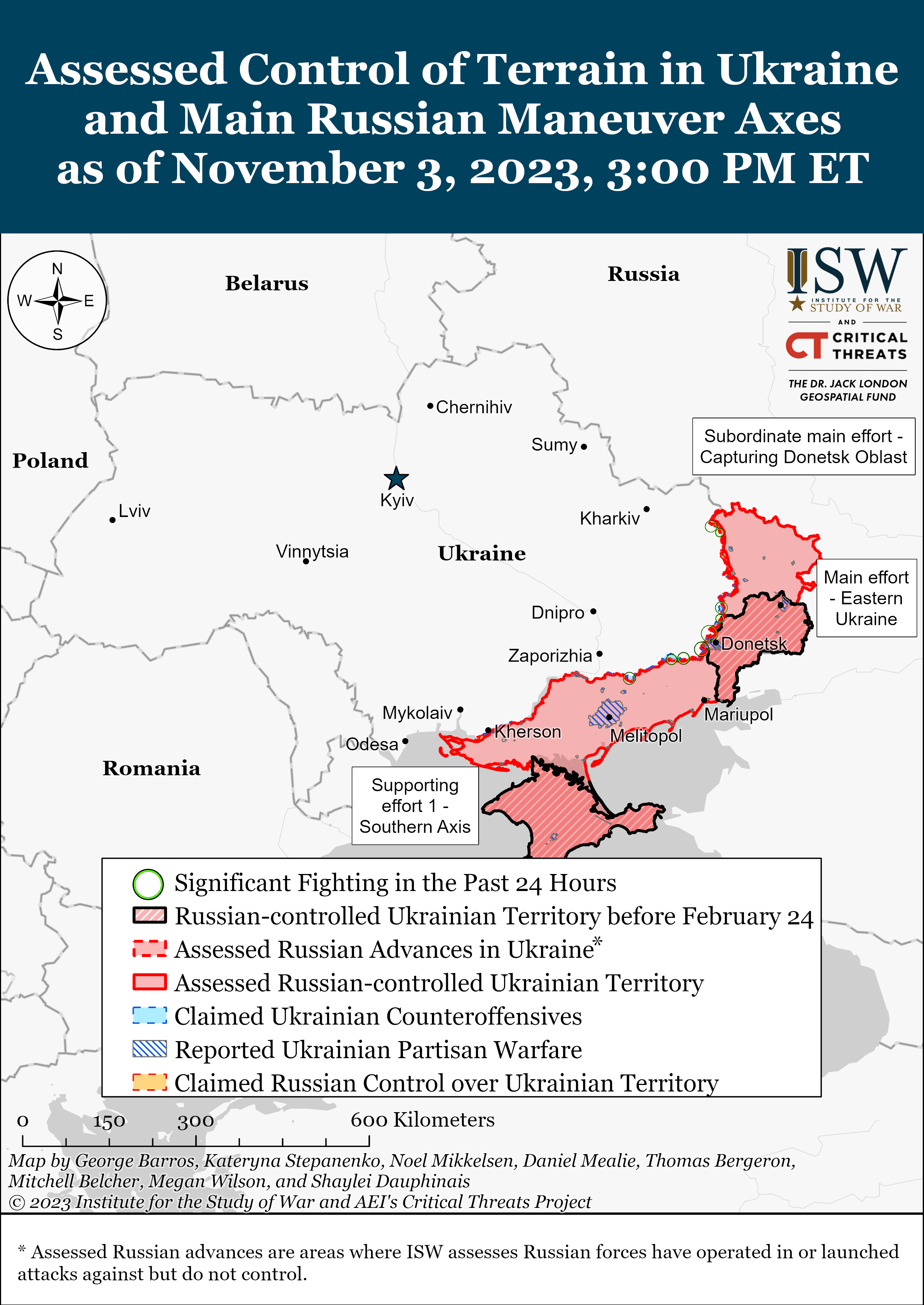
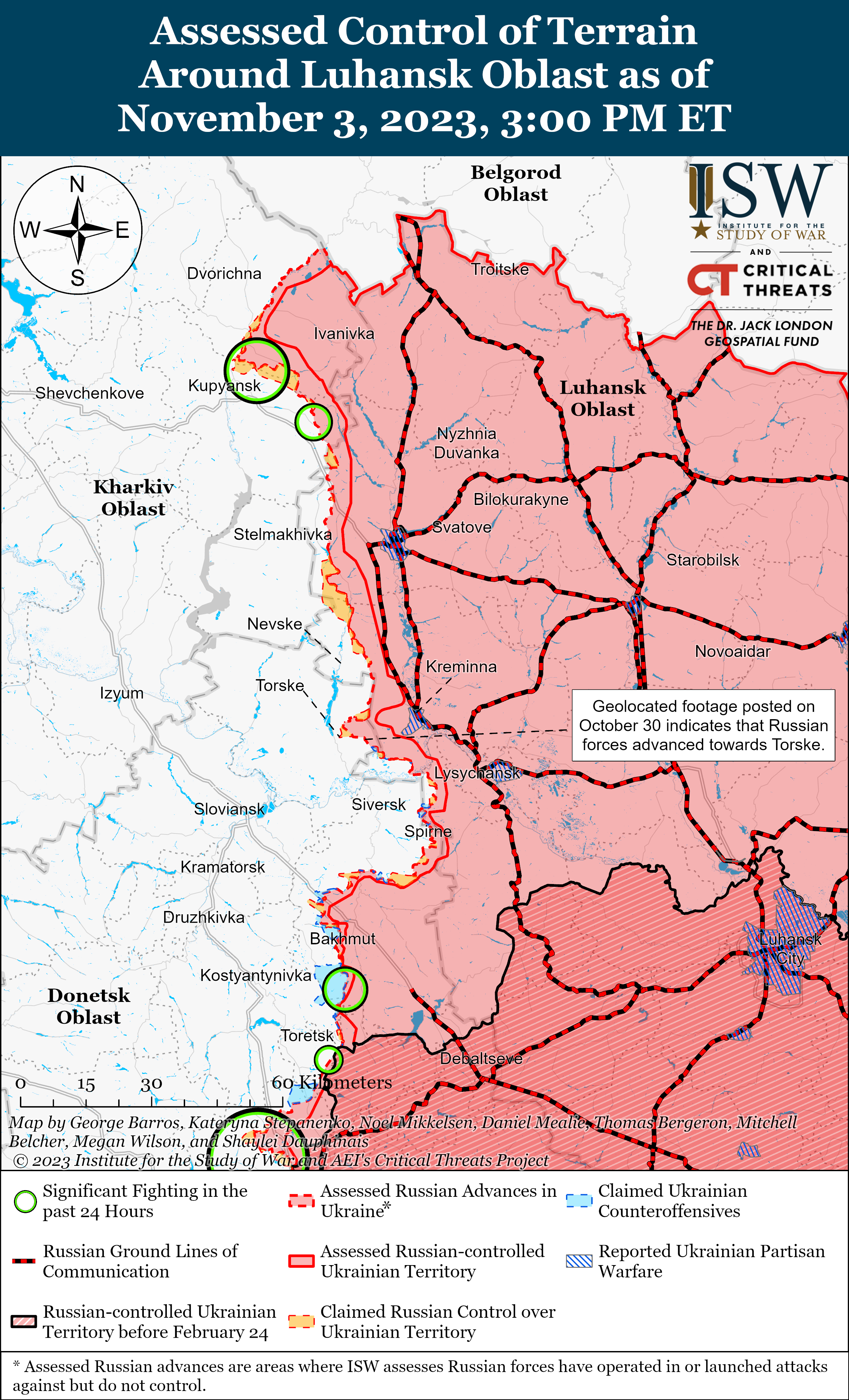
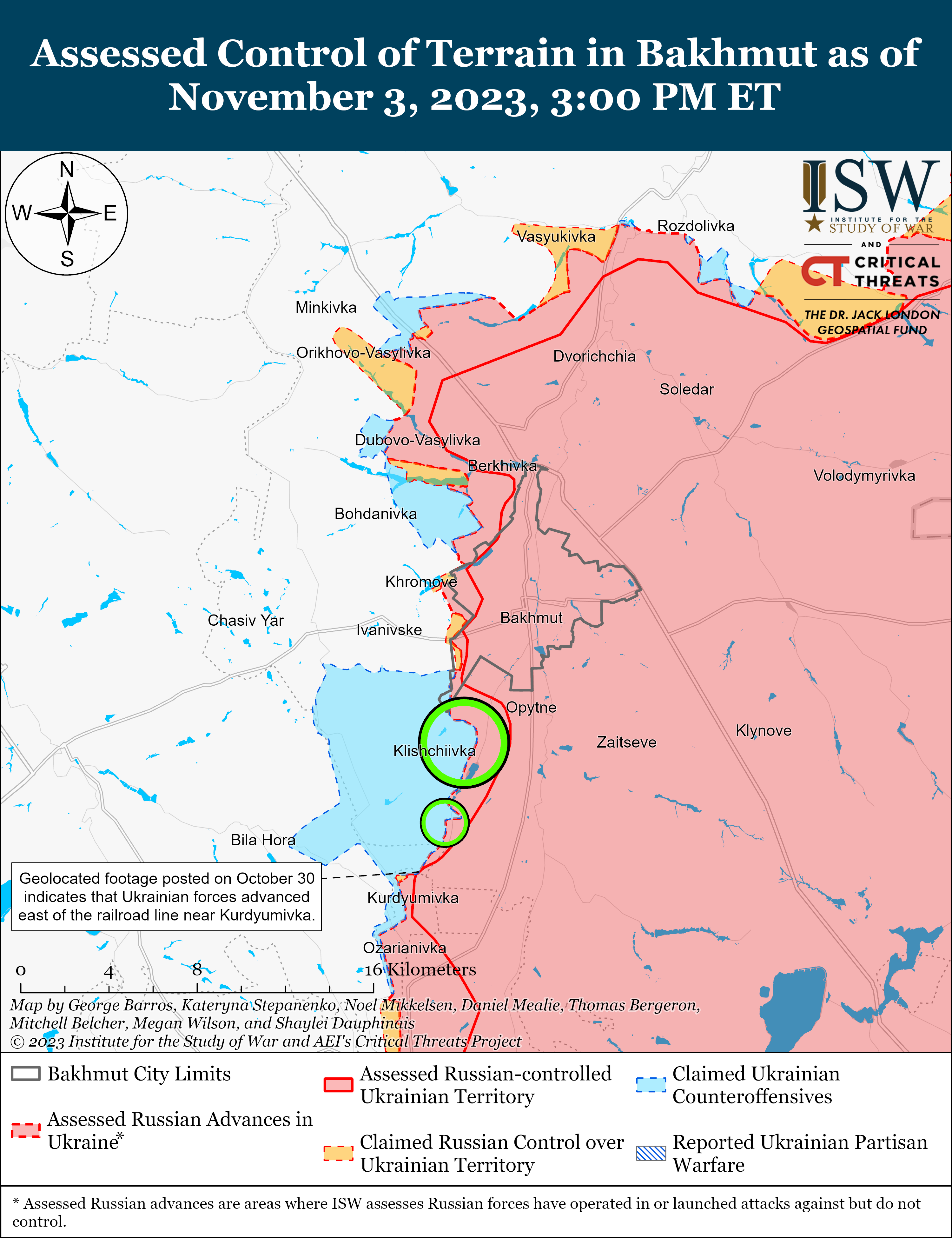
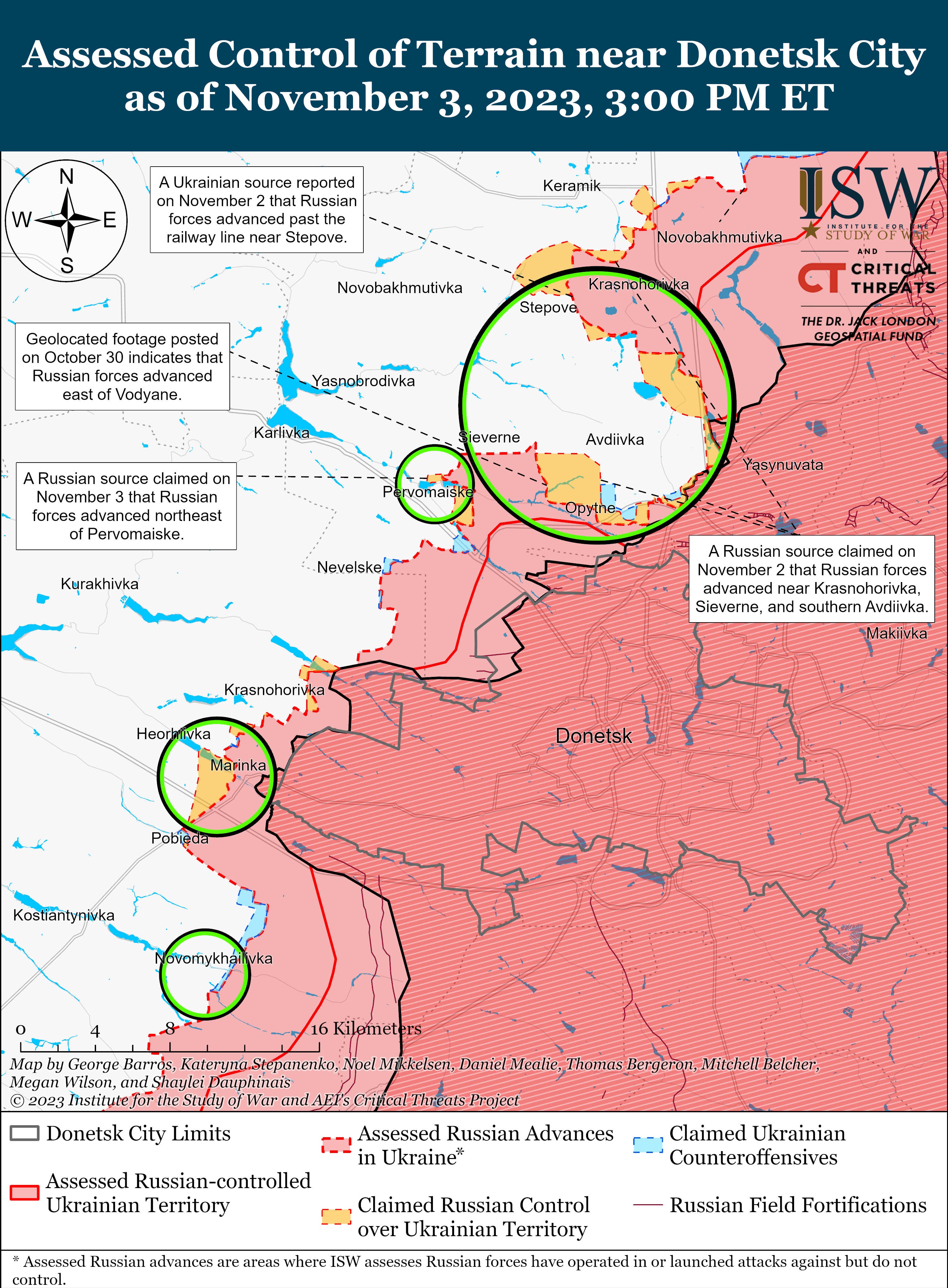
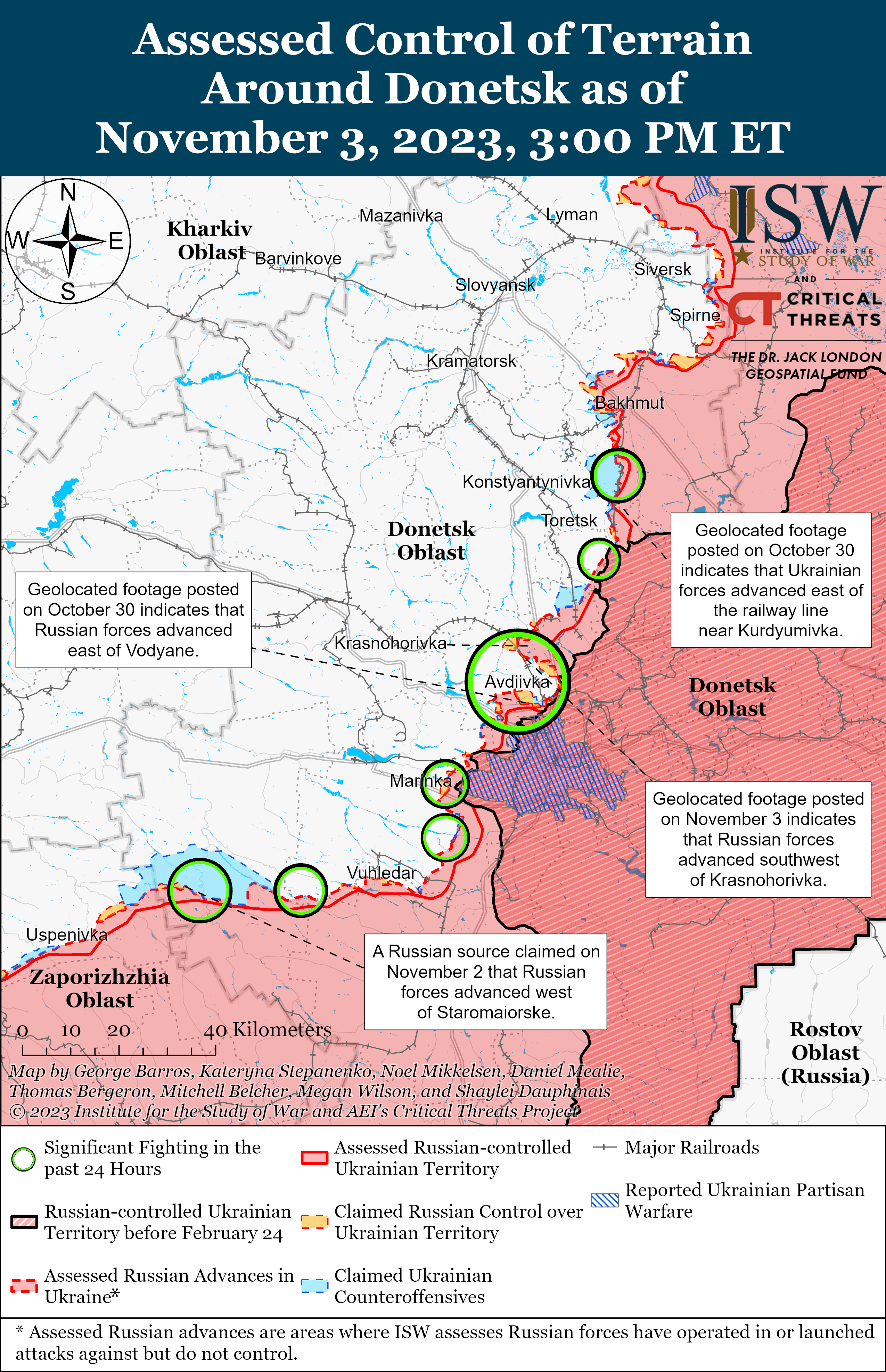
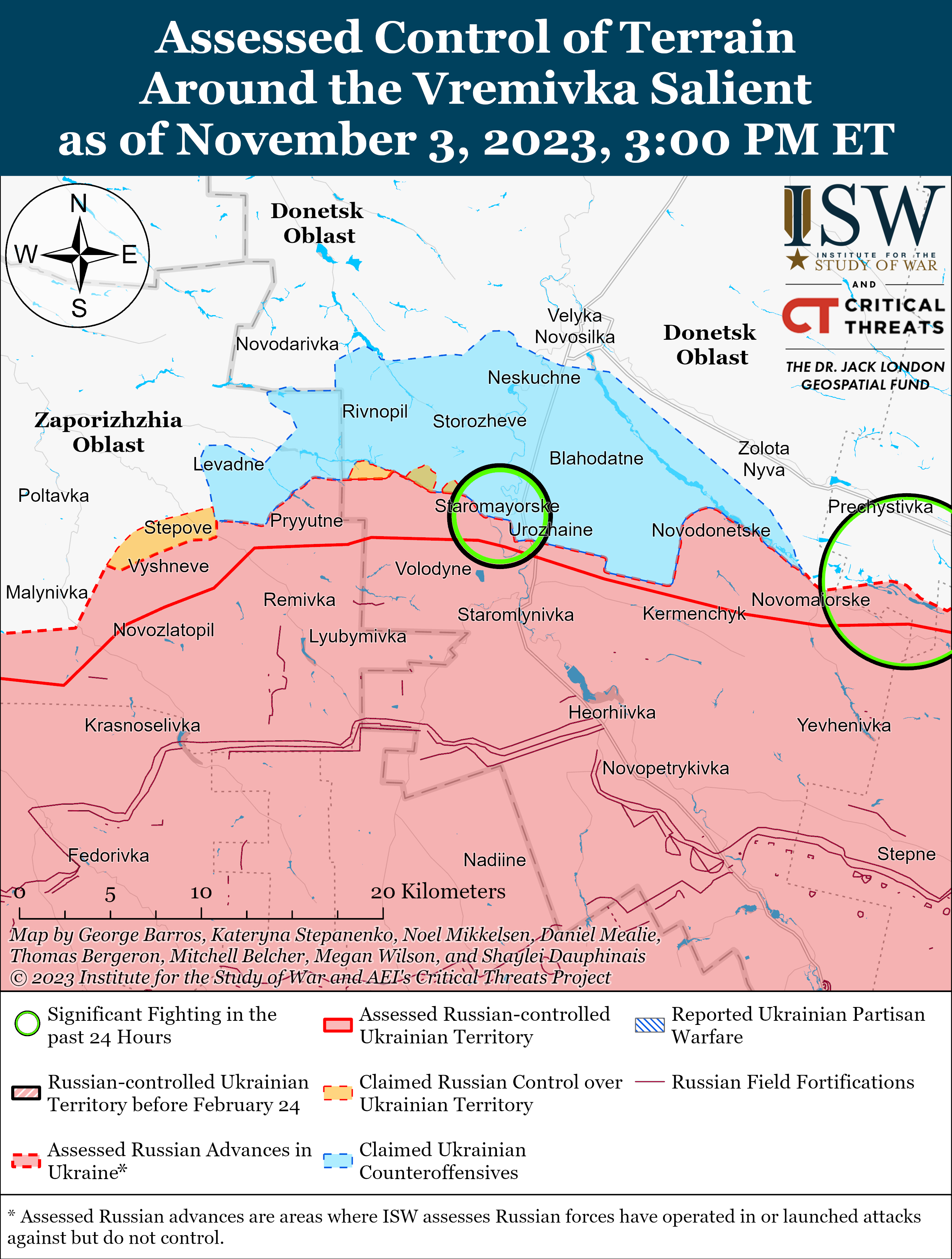
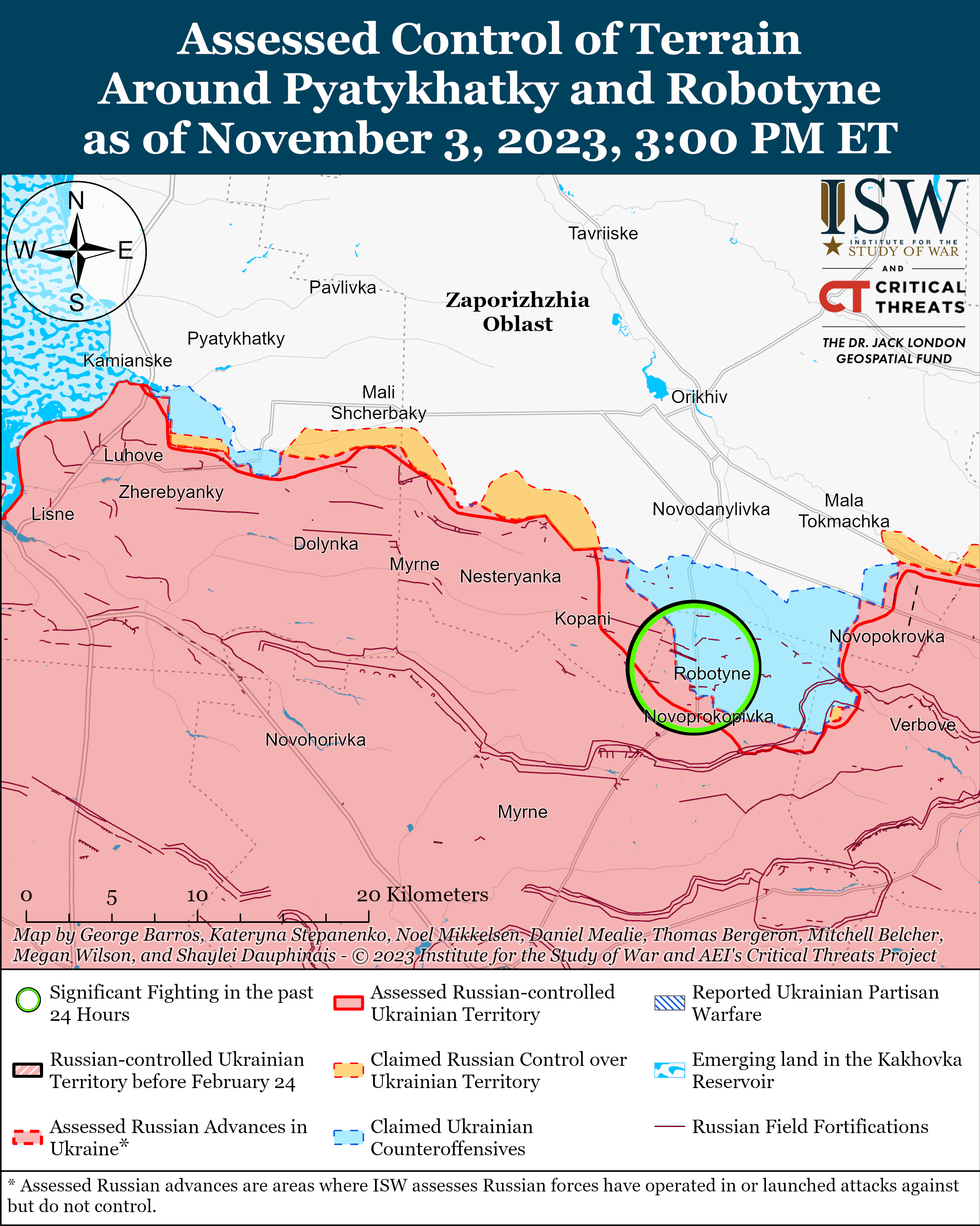
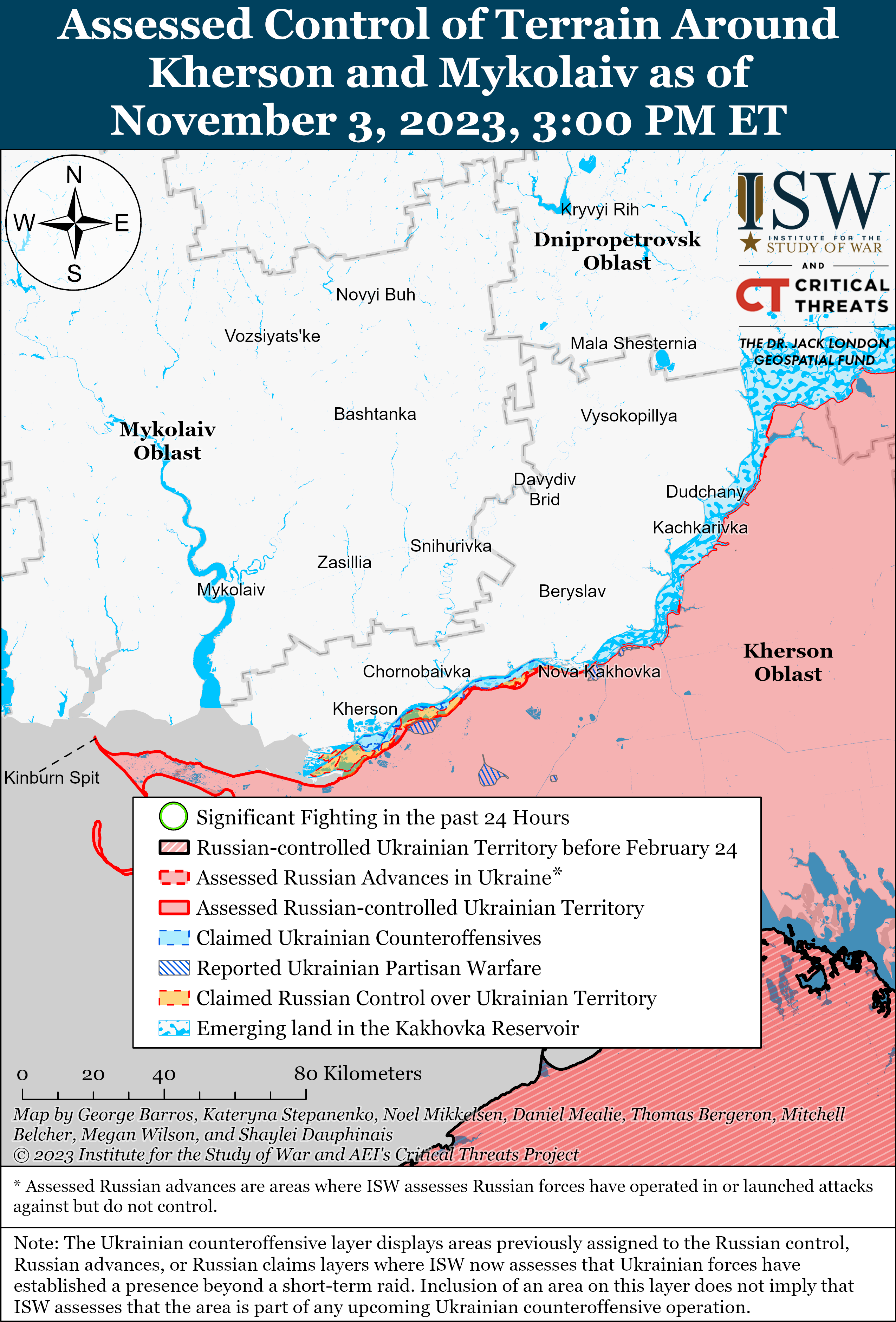
No comments:
Post a Comment